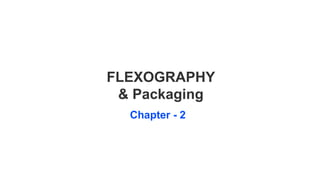
Chapter -2 - Flexography & Packaging-MAH- 12-2022.ppt
- 2. ● 4 – 8 Color units ● Limited to one side printing ● Ideal press for hairline register at high speeds on stretchable films ● Longer make-ready times required because printing units are more difficult to access Central Impression Press
- 3. ● 1 – 8 Color units ● Some presses can print on both sides ● Traps should be no less than 1/64” for thin films ● Often used inline with other converting operations such as lamination, rotary and flat bed diecutting, and sideseal bag converting Stack Press
- 4. ● Up to 12 color units ● Can print two sides with the aid of a turn-bar ● Used for printing thick substrates such as paperboard ● Often used inline with other converting operations such as lamination,rotary and flatbed diecutting, cross perforation. In-Line Press
- 5. ● Same configuration as the inline press ● Sheet-fed; widths up to 120 “ ● Usually no more than 4 color ● Limited to one sided printing ● Less accurate registration capabilities Corrugated Press
- 6. Plate cylinders with different diameters can be mounted on many flexographic presses, allowing for variable repeat lengths. Printing a roll of packaging, such as gift wrap, uses a continuous repeat, where the same set of images is repeated many times on a continuous stream of substrate. To avoid the plate seam, images may require nesting, an arrangement that creates a staggered effect. Staggering images gives the appearance that the design is continuous, no matter where the substrate is cut. Repeat Length
- 7. ● Molded rubber plates shrink when they are removed from the molding press. Plate films should be adjusted to compensate for shrinkage, which is typically 1.5% - 2.0% in the direction of the rubber grain, and 0.5% - 1% across it. ● Exact shrinkage amounts should be communicated between production artists and platemakers. ● Line screening is limited to 120 lpi ● Registration can be more difficult than with photopolymer plates. ● Nesting is required for the appearance of continuous repeat. ● It is difficult to mold accurate rubber plates larger than 24”x 36”. Larger designs must be placed on multiple plates for each other. Plate types (Molded Rubber)
- 8. ● Line screening is at least 150 lpi and can be as high as 200 lpi. ● Nesting is required for the appearance of continuous repeat. ● Positioning and register devices on most modern flexographic presses are designed for one-piece photpolymer plates. ● Direct-to-plate laser imaging is available Plate types (Photopolymer)
- 9. ● Line screening is limited to 100 lpi for tone reproduction, but can be 200 to 300 lpi for tints. ● Film is not required ● Design rolls can provide a true continuous repeat with a continuous background color. ● Plates or design rolls imaged directly on the cylinder do not require compensation for plate elongation. ● Laser ablating is available for both rubber and photopolymer Plate types (Laser Ablated)
- 10. When designing images for flexographic printing, it is important to understand the effects of plate elongation. Because flexographic plates are made with soft material, they tend to stretch when mounted on the plate cylinder,sometimes distorting images and text. A circle, for example, may be stretched to look more like oval. Fortunately,special flexographic software can compensate for plate elongation by slightly distorting images. Plates Elongation
- 11. Distortion is usually performed within the flexographic software application or at the RIP stage before the film is imaged. The amount of distortion depends on the thickness of the plate and the mounting tape used to fasten it, and on the circumference of the cylinder(the repeat length). In general, thicker plates and shorter repeat lengths increase the elongation. To be sure that images will be printed with the correct size and shape, the design should be output to film after plate thickness has been determined and the proper distortion factor has been applied. Plates Distortion
- 12. Flexography is ideal for printing packaging materials because the soft plates can transfer ink to many different kinds of substrates- --anything from corrugated board to candy wrappers. The qualilty of a printed product is determined not only by the type of plate, but also by the substrate itself. Different substrates allow varying degrees of ink absorption, gloss, brightness, and color defination. Substrates
- 13. Because the appeal of packaging is significantly enhanced by color, flexographic presses commonly offer six & eight colors, and even as many as twelve for limited applications. Designers can choose from a number of different combinations, including multiple spot colors and HIFI printing, which is a method of increasing the color gamut by printing six or seven process colors. Color capabilities
- 14. Most flexographic inks consist of opaque or semi-opaque pigments. To ensure proper ink coverage, the spot colors are usually printed from lightest to darkest. Process colo inks are made from transparent pigments and can be applied in any sequence. Transparent substrates, such as polypropylene, require a white backup plate provided by a “Choke” plate, as a background for colors; otherwise, colors would appear flat and translucent. Another technique used for applying inks to transparent substrates is reverse-side printing. The image is laterally reversed, and colors are printed instead from darkest to lightest; the packaging is then displayed from the non-ink side of the substrate. This provides a scratch proof surface to the ink layer, and a glossy finish. In some cases waterbased ink is used for reverse-side printing lamination. Color capabilities
- 15. To be continued Author : Mohammed Abdul Haleem Email : ah.flexomaster@gmail.com With almost 29 years of experience in the Printing industry, he offers proactive recommendations on anilox roll specifications, testing, inventory management, flexographic equipments applications,training, drawing from experience in technical sales,marketing,production,technical service,parts and supplies. His experience covers the spectrum of flexographic markets including: wide web film, narrow web, tag & labels,foil, folding carton, corrugated packaging applications